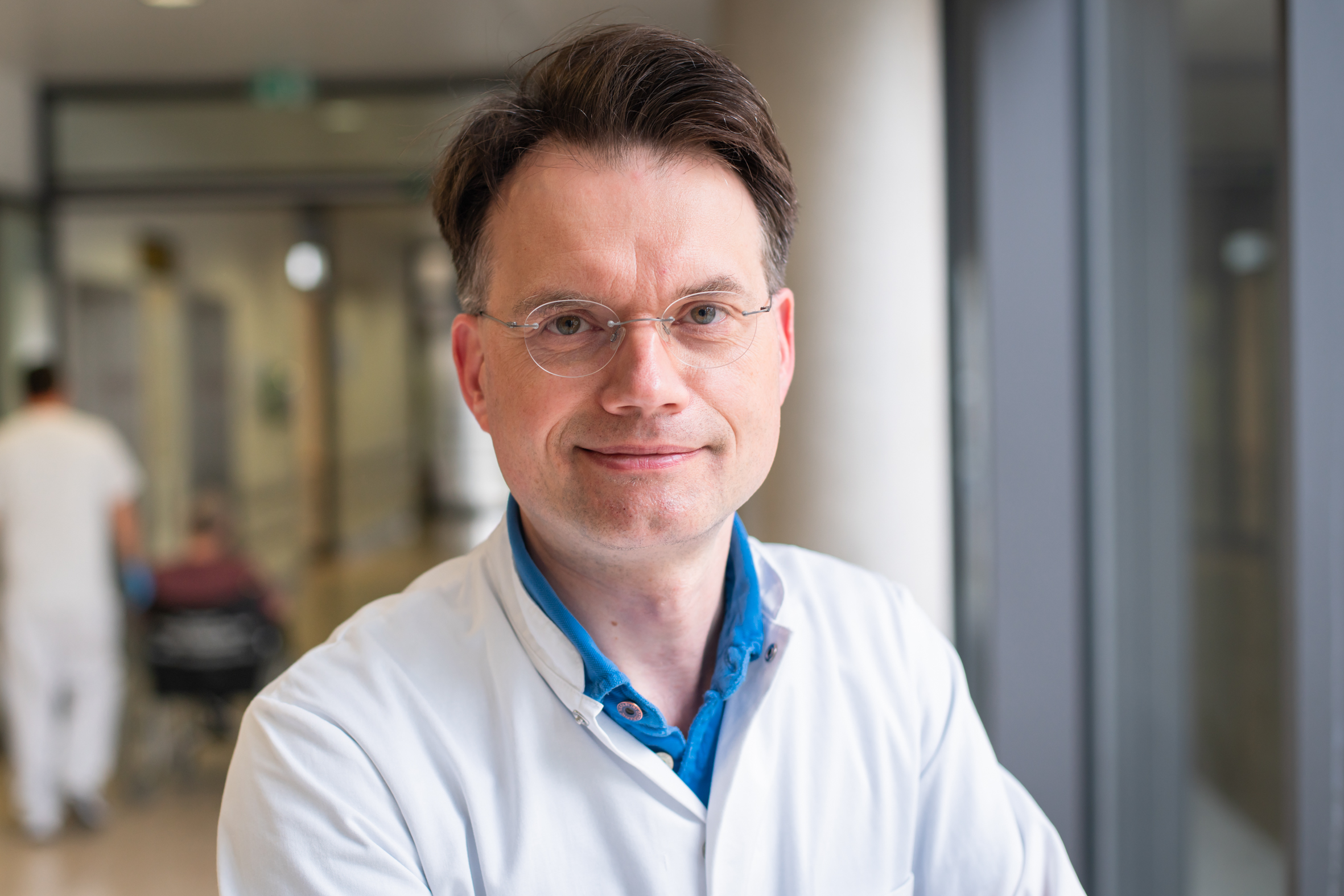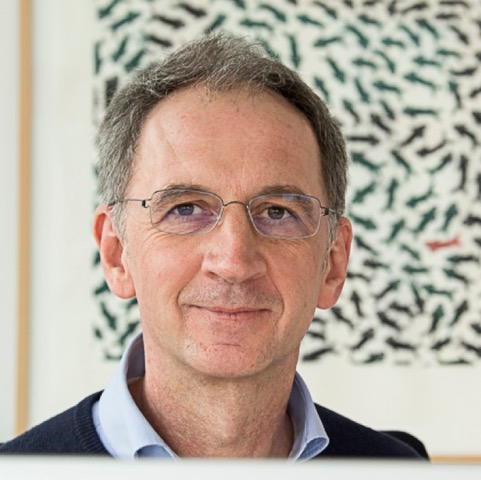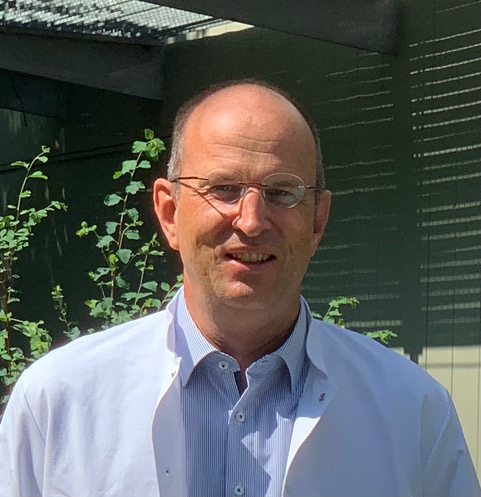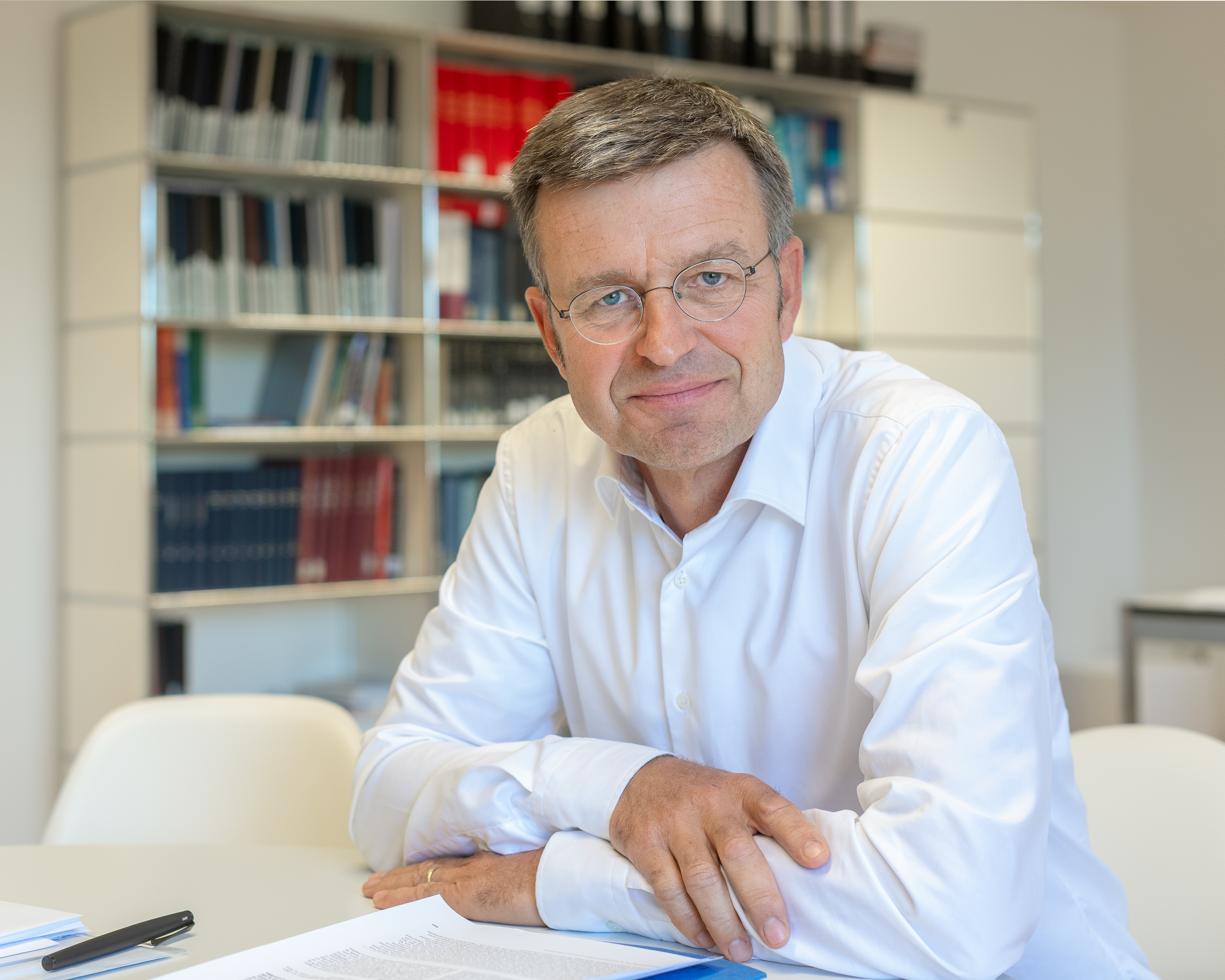Team
Imaging

https://web.med.tum.de/cbi/home/


My laboratory is focused on developing next generation molecular imaging and control technology for neuroscience.
Our goal is to obtain dynamic information on molecular events in neurons to monitor neural activity across entire intact brains and thereby complement optical methods mostly restricted to invasive imaging of small areas of the brain surface.
To this end, we employ bioengineering and genetic techniques, chemistry as well as nanotechnology to generate molecular contrast agents that translate molecular processes of interest into dynamic signals detectable by non-invasive imaging technology such as Magnetic Resonance Imaging (MRI) or Optoacoustics. Complementarily, we work on molecular devices to control cellular processes non-invasively.
We validate this methodology with a variety of biochemical and cell culture methods and apply it to fundamental questions in neuroscience and preclinical models of neuropsychiatric diseases.
Selected publications:
Stiel, A. C. et al. High-contrast imaging of reversibly switchable fluorescent proteins via temporally unmixed multispectral optoacoustic tomography. Optics letters 40, 367–370 (2015).
Westmeyer, G. G., Emer, Y., Lintelmann, J. & Jasanoff, A. MRI-Based Detection of Alkaline Phosphatase Gene Reporter Activity Using a Porphyrin Solubility Switch. Chem. Biol. 21, 422–429 (2014).
Shapiro*, M. G., Westmeyer*, G. G., Romero, P. A., Szablowski, J. O., Kuster, B., Shah, A., Otey, C. R., Langer, R., Arnold, F. H., and Jasanoff, A. (2010) "Directed evolution of a magnetic resonance imaging contrast agent for noninvasive imaging of dopamine", Nat Biotechnol 28: 264-270; * contributed equally
Westmeyer, G. G., Durocher, Y., and Jasanoff, A. (2010) "A secreted enzyme reporter system for MRI", Angew Chem Int Ed Engl 49: 3909-391
Westmeyer, G. G., and Jasanoff, A. (2007) "Genetically controlled MRI contrast mechanisms and their prospects in systems neuroscience research", Magn Reson Imaging 25: 1004-1010
Shapiro, M. G., Atanasijevic, T., Faas, H., Westmeyer, G. G., and Jasanoff, A. (2006) "Dynamic imaging with MRI contrast agents: quantitative considerations", Magn Reson Imaging 24: 449-462
Infection and Immunology

The major focus of the Busch laboratory is to visualize and track antigen-specific T cell populations during in vivo antigen challenge to increase our understanding of how T cell responses are regulated in vivo and how protective and long lasting immunity is established. This knowledge is of special interest for adoptive immunotherapy, diagnostic monitoring of T cell mediated immunity, and the development of new vaccination strategies.
Antigen-specific T cell responses are of major importance in the control of infection and the development of protective immunity. T cells can also mediate anti-tumor effects and, in the case of autoimmune syndromes, can contribute to the development and pathology of disease.
Over the last few decades, numerous epitopes recognized by antigen-specific T cells have been identified, and general features of T cell responses revealed. Due to the difficulty of identifying antigen-specific T cells directly ex vivo, however, many basic questions regarding the in vivo regulation of antigen-specific T cell responses and the generation of protective immunity are still unsolved. Using new immunological methods, especially MHC multimer technologies, we are now able to directly identify and isolate T cells depending on their antigen specificity.
The goal of this lab is to further develop these new advances in immunological techniques, to investigate antigen-specific T cell responses in an animal model and to test direct clinical applications of the technology.
Selected publications:
Buchholz, V. R., Flossdorf, M., Hensel, I., Kretschmer, L., Weissbrich, B., Graf, P., Verschoor, A., Schiemann, M., Hofer, T., and Busch, D. H. (2013) Disparate Individual Fates Compose Robust CD8+ T Cell Immunity, Science 340(6132):630-5.
Nauerth, M., Weißbrich, B., Knall, R., Franz, T., Dössinger, G., Bet, J., Paszkiewicz, P.J., Pfeifer, L., Bunse, M., Uckert, W., Holtappels, R., Gillert-Marien, D., Neuenhahn, M., Krackhardt, A., Reddehase, M. J., Riddell, S. R., and Busch, D. H. (2013) TCR-ligand koff-rate predicts protective capacity of antigen-specific CD8+ T cells for adoptive transfer. Science Translational Medicine 5(192):192ra87.
Busch D.H., I.M. Pilip, S. Vijh, and Pamer E.G. (1998) Coordinate regulation of complex T cell populations responding to bacterial infection. Immunity 8: 353-362.
Knabel M, Franz TJ, Schiemann M, Wulf A, Villmow B, Schmidt B., Bernhard H., Wagner H, and Busch DH (2002). Reversible MHC multimer staining for functional isolation of T cell populations and effective adoptive transfer. Nature Medicine, 8; 631-637.
Huster K.M., Busch V., Schiemann M., Linkemann K., Kerksiek K.M., Wagner H. and Busch D.H. (2004). Selective expression of IL-7 receptor on memory T cells identifies early CD40L-dependent generation of distinct CD8+ memory T cell subsets. PNAS 101(15):5610-5.
Neuenhahn M., Kerksiek K.M., Nauerth M., Suhre M.H., Schiemann M., Gebhardt F.E., Stemberger C., Panthel K., Schröder S., Chakraborty T., Jung S., Hochrein H., Rüssmann H., Brocker T. , and Busch D.H. (2006) CD8alpha-positive dendritic cells are required for efficient entry of Listeria monocytogenes into the spleen. Immunity Oct;25(4):619-30.
Stemberger C., Huster H., Koffler M., Anderl F., Schiemann M., Wagner H., and Busch D.H. (2007) A single naive CD8+ T cell precursor can develop into diverse effector and memory subsets. Immunity. 2007 Dec;27(6):985-97.

Our group is interested in studying the molecular mechanisms determining local regulation of immune responses in tissues, in particular in the liver. We employ modern cutting edge technologies to characterize the interaction of immune cells with tissue cells and how this shapes the quality of immune responses in the context of pathogen infection, metabolic challenges and chronic inflammation leading to tumor development. Understanding the principles of local regulation of immune responses is key to understand the molecular pathophysiology of organ-specific diseases. Such knowledge forms the basis for developing next-generation immune therapies based on novel concepts for therapeutic vaccination and for improving immune diagnostics through quantitative measurement of immune responses in tissues.
We are focusing on the regulation of immune responses in the liver and how the mechanistic understanding of the local balance between immunogenic and tolerogenic signals can be employed to achieve clearance of chronic viral infections and to eradicate tumor cells from the liver. We are further exploring the role of the liver in systemic immunity and how T cells primed in the liver contribute to protective immunity against pathogen infection.
We invite you to explore our homepage for further information.
Selected publications:
Thomson AW, Knolle PA. Antigen-presenting cell function in the tolerogenic liver environment. Nat Rev Immunol 2010, 10(11): 753-766.
Protzer U, Maini MK, Knolle PA. Living in the liver: hepatic infections. Nat Rev Immunol 2012, 12(3): 201-213.
Wohlleber D, Kashkar H, Gartner K, Frings MK, Odenthal M, Hegenbarth S, Limmer A, Cederbrant K, Heikenwalder M, Pasparakis M, Protzer U, Dienes HP, Kurts C, Kronke M, Knolle PA. TNF-Induced Target Cell Killing by CTL Activated through Cross-Presentation. Cell Reports 2012, 2(3): 478-487.
Huang LR, Wohlleber D, Reisinger F, Jenne CN, Cheng RL, Abdullah Z, Schildberg FA, Odenthal M, Dienes HP, van Rooijen N, Schmitt E, Garbi N, Croft M, Kurts C, Kubes P, Protzer U, Heikenwalder M, Knolle PA. Intrahepatic myeloid-cell aggregates enable local proliferation of CD8(+) T cells and successful immunotherapy against chronic viral liver infection. Nat Immunol 2013, 14(6): 574-583.
Böttcher JP, Schanz O, Wohlleber D, Abdullah Z, Debey-Pascher S, Staratschek-Jox A, Hochst B, Hegenbarth S, Grell J, Limmer A, Atreya I, Neurath MF, Busch DH, Schmitt E, van Endert P, Kolanus W, Kurts C, Schultze JL, Diehl L, Knolle PA. Liver-Primed Memory T Cells Generated under Noninflammatory Conditions Provide Anti-infectious Immunity. Cell Reports 2013, 3(3): 779-795.
Böttcher JP, Schanz O, Garbers C, Zaremba A, Hegenbarth S, Kurts C, Beyer M, Schultze JL, Kastenmuller W, Rose-John S, Knolle PA. IL-6 trans-Signaling-Dependent Rapid Development of Cytotoxic CD8(+) T Cell Function. Cell Reports 2014, 8(5): 1318-1327.
Wolf MJ, Adili A, Piotrowitz K, Abdullah Z, Unger K, Karin M, Kopf M, Knolle P, Weber A, Heikenwalder M. Metabolic Activation of Intrahepatic CD8(+) T Cells and NKT Cells Causes Nonalcoholic Steatohepatitis and Liver Cancer via Cross-Talk with Hepatocytes. Cancer Cell 2014, 26(4): 549-564.

In our research, we try to understand why autoreactive T cell responses can result in organ specific autoimmunity like multiple sclerosis or neuromyelitis optica. Autoreactive T cells occur in any "normal" T cell repertoire, but are kept in check by mechanisms of dominant tolerance like for example regulatory T cells (Tregs). We are interested in identifying molecular switches and cytokine networks that break immunological tolerance in the peripheral immune compartment and direct the fate of an autoreactive T cell to become autopathogenic. Validation of molecular targets is performed in animal models of multiple sclerosis like for example experimental autoimmune encephalomyelits.
Selected publications:
Garg G, Muschaweckh A, Moreno H, Vasanthakumar A, Floess S, Lepennetier G, Oellinger R, Zhan Y, Regen T, Hiltensperger M, Peter C, Aly L, Knier B, Palam LR, Kapur R, Kaplan MH, Waisman A, Rad R, Schotta G, Huehn J, Kallies A & Korn T. (2019) Blimp1 prevents methylation of Foxp3 and loss of regulatory T cell identity at sites of inflammation. Cell reports, 26 (7): 1854-1868.e5.
Knier B, Hiltensperger M, Sie C, Aly L, Lepennetier G, Engleitner T, Garg G, Muschaweckh A, Mitsdörffer M, Koedel U, Höchst B, Knolle P, Gunzer M, Hemmer B, Rad R, Merkler D & Korn T. (2018) Myeloid-derived suppressor cells control B cells within the central nervous system during autoimmunity. Nature Immunology, 19 (12): 1341-1351.
Heink S, Yogev N, Garbers C, Herwerth M, Aly L, Gasperi C, Husterer V, Croxford AL, Möller-Hackbarth K, Bartsch HS, Sotlar K, Krebs S, Regen T, Blum H, Hemmer B, Misgeld T, Wunderlich TF, Hidalgo J, Oukka M, Rose-John S, Schmidt-Supprian M, Waisman A & Korn T. (2017) Dendritic cells are non-redundant sources of IL-6 for the priming of pathogenic Th17 cells due to a novel mode of IL-6 signaling. Nature Immunology, 18: 74-85.
Petermann F, Rothhammer V, Claussen MC, Haas JD, Riol-Blanco L, Heink S, Prinz I, Hemmer B, Kuchroo VK, Oukka M & Korn T. (2010) γδ T cells enhance autoimmunity by restraining Treg responses via an IL-23 dependent mechanism. Immunity, 33: 351-363.
Korn T, Bettelli E, Gao W, Awasthi A, Jäger A, Strom TB, Oukka M & Kuchroo VK. (2007) IL-21 initiates an alternative pathway
Korn T, Reddy J, Gao W, Bettelli E, Awasthi A, Petersen TR, Bäckström BT, Sobel RA, Wucherpfennig KW, Strom TB, Oukka M & Kuchroo VK. (2007) Myelin-specific regulatory T cells accumulate in the CNS but fail to control autoimmune inflammation. Nature Medicine, 13: 423-431.
http://www.kornlab.med.tum.de/

Our main scientific interests are to better understand the interaction of hepatitis B virus (HBV) with its host and to develop new (gene and immune) therapeutic strategies to treat chronic viral hepatitis and hepatocellular carcinoma.
The majority of the team is currently focusing on how HBV is controlled by cellular defense mechanisms and by the systemic immune response, and how HBV manages to escape this immune control. To be able to study this, we have developed new animal and cell culture models of HBV infection and new molecular diagnostic assays. We have established two HBV-transgenic mouse lines as models for a vertical transmission, and have developed a mouse model of self-limited hepatitis B.
Based on an improved basic understanding of the control of HBV infection we are developing new treatment strategies to treat chronic viral hepatitis. For example, we study the molecular mechanisms of antiviral effects of cytokines and other immune mediators, and investigate the possibility of a therapeutic cytokine gene transfer. Since we are convinced that immune tolerance needs to be overcome to cure chronic infection, we also follow strategies of therapeutic vaccination and try to redirect T cells to infected cells by generating recombinant T cell receptors. By grafting them onto primary T cells we follow a novel strategy in the treatment of infectious diseases.
Other topics of our group are metabolic alterations caused by hepatitis C virus, T cell therapy of HCV and hepatocellular cacinoma and developing new vectors systems for a liver directed gene transfer. As the first group worldwide, we managed to generate HBV based viral vectors. Recently, we successfully used HBV based vectors in a preclinical study in HCV infected chimpanzees.
Selected publications:
Hösel M, Quasdorff M, Webb D, Zedler U, Esser K, Arzberger S, Wiegmann K, Kirschning CJ, Langenkamp A, Rose-John S and Protzer U. Not interferon, but IL-6 controls early gene expression in Hepatitis B virus (HBV) infection. Hepatology 2009, 50:1773-1782.
Bohne F, Chmielewski M, Ebert G, Wiegmann K, Kürschner T, Schulze A, Urban S, Krönke M, Abken H, Protzer U. T cells Redirected Against Hepatitis B Virus Surface Proteins Eliminate Infected Hepatocytes. Gastroenterology 2008, 134: 239-47.
Quasdorff M, Hösel M, Odenthal M, Zedler U, Bohne F, Gripon P, Dienes HP, Stippel D, Goeser T, Protzer U. A concerted action of HNF1 a and HNF4a links hepatitis B virus replication to hepatocyte differentiation. Cellular Micobiology 2008, 10:1478-1490.
Protzer U, Seyfried S, Quasdorff M, Sass G, Svorcova M, Webb D, Bohne F, Hösel M, Schirmacher P, Tiegs G.
Antiviral activity and hepatoprotection by heme oxygenase-1 in hepatitis B virus infection. Gastroenterology 2007, 133: 1156-65.
Untergasser A, Zedler U, Langenkamp A, Hösel M, Quasdorff M, Esser K, Tapperzhofen B, Kolanus W and Protzer U. Dendritic cells take up viral antigens but do not support the early steps of hepatitis B virus infection. Hepatology 2006, 43: 539-547.
Untergasser A & Protzer U. Hepatitis B virus vectors allow elimination of viral gene expression and insertion of foreign promoters. Human Gene Therapy 2004, 15: 203-210.
Sprinzl M, Oberwinkler H, Schaller H, Protzer U.
Hepatitis B virus genome transfer with adenoviral vectors into cultured cells and mice: crossing the species barrier Journal of Virology 2001, 75: 5108-5118.
U. Klöcker, U. Schultz, H. Schaller, U. Protzer.
Liver macrophages release mediators after endotoxin stimulation that inhibit an early step in hepadnavirus replication. Journal of Virology 2000, 74 (12): 5525-5533.
Protzer U, Nassal M, Chiang PW, Kirschfink M, Schaller H. Interferon gene transfer by a novel hepatitis B virus vector efficiently suppresses wildtype-virus infection. PNAS 1999, 96: 10818-10823.
https://web.med.tum.de/virologie/home/

Our Laboratory is interested in the molecular mechanisms of immune cell activation and in the pathogenesis of cancer. Using a wide variety of molecular, cellular and in vivo techniques we try to understand how the innate immune system detects microbial or endogenous danger and how subsequent intracellular signals drive inflammatory responses and host defense. In other projects, we are dissecting pathomechanisms of leukemia and lymphoma development and build novel models for these diseases. We hope that our work will contribute to the development of novel diagnostics and therapeutics for immune-mediated diseases and cancer.
Selected publications:
Rosenbaum, M., Gewies, A., Pechloff, K., Heuser, C., Engleitner, T., Gehring, T., Hartjes, L., Krebs, S., Krappmann, D., Kriegsmann, M., Weichert, W., Rad, R., Kurts, C., Ruland, J. (2019). Bcl10-controlled Malt1 paracaspase activity is key for the immune suppressive function of regulatory T cells. Nat Commun 10, 2352.
Wartewig, T., Kurgyis, Z., Keppler, S., Pechloff, K., Hameister, E., Ollinger, R., Maresch, R., Buch, T., Steiger, K., Winter, C., Rad, R., Ruland, J. (2017). PD-1 is a haploinsufficient suppressor of T cell lymphomagenesis. Nature 552, 121-125.
Knies, N., Alankus, B., Weilemann, A., Tzankov, A., Brunner, K., Ruff, T., Kremer, M., Keller, U.B., Lenz, G., Ruland, J. (2015). Lymphomagenic CARD11/BCL10/MALT1 signaling drives malignant B-cell proliferation via cooperative NF-kappaB and JNK activation. Proc Natl Acad Sci U S A 112, E7230-8.
Roth, S., Rottach, A., Lotz-Havla, A.S., Laux, V., Muschaweckh, A., Gersting, S.W., Muntau, A.C., Hopfner, K.P., Jin, L., Vanness, K., Petrini, J.H., Drexler, I., Leonhardt, H., Ruland, J. (2014). Rad50-CARD9 interactions link cytosolic DNA sensing to IL-1beta production. Nat Immunol 15, 538-45.
Neumann, K., Castineiras-Vilarino, M., Hockendorf, U., Hannesschlager, N., Lemeer, S., Kupka, D., Meyermann, S., Lech, M., Anders, H.J., Kuster, B., Busch, D.H., Gewies, A., Naumann, R., Gross, O., Ruland, J. (2014). Clec12a is an inhibitory receptor for uric acid crystals that regulates inflammation in response to cell death. Immunity 40, 389-99.
Strasser, D., Neumann, K., Bergmann, H., Marakalala, J.M., Guler, R., Rojowska, A., Hopfner, K., Brombacher, F., Urlaub, H., Baier, G., Brown, G. Leitges, M., and Ruland, J. (2012) Syk-coupled C-type lectin receptors engage PKCdelta to elicit Card9 mediated innate immunity. Immunity 36, 32-42
http://www.klinchem.med.tum.de/de/startseite

Environmental disease such as COVID19 or allergies are a major burden for our societies. They challenge the epithelial surfaces in an interplay with the immune system. Allergy is among the most frequent disease world wide and is further increasing in prevalence and will further aggravate with climate changes. Key aim is to understand natural tolerance mechanisms as well as therapeutic re-induction by treatment, convalescence or naturally remission. To prevent pandemics and epidemics in the future the ZAUM is monitoring the the environment and was able to install an automatic pollen measurement network in Bavaria. For COVID19 and other airway diseases we are exploring non-invasive diagnosis option using biomarker that are identified in our basic research activities. Also for skin barriers dramatic progress could be generated and novel diagnostic approaches are developing out of basic research based on human biobank samples.
Being a hybrid institute of TUM and Helmholtz Society, the institute takes advantage of cutting edge technologies as well as the strength of an university clinic. The institute offers a unique range of expertise from genetics over omics to bedside that has previously promoted careers with international recognition. ERC and EU, BMBF and DFG grants are lead by the team. ZAUM PIs are also member of several SFB/TRs and are also member of the German Center of Lung Research (DZL), and generated over the last 5 years more than 15 million € research funding. Graduates from ZAUM get usually employment opportunities from all over the world due to the outstanding publication record, 4 Profs were promoter from ZAUM alumni.
Selected publications:
de Los Reyes Jimenez, M. et al. An anti-inflammatory eicosanoid switch mediates the suppression of type-2 inflammation by helminth larval products. Sci Transl Med 12, (2020).
Zissler, U. M. et al. Early IL-10 producing B-cells and coinciding Th/Tr17 shifts during three year grass-pollen AIT. EBioMedicine 36, 475-488, (2018).
Oteros, J. et al. Artemisia pollen is the main vector for airborne endotoxin. J Allergy Clin Immunol 143, 369-377 e365, (2019).
Garzorz-Stark, N. et al. Toll-like receptor 7/8 agonists stimulate plasmacytoid dendritic cells to initiate TH17-deviated acute contact dermatitis in human subjects. J Allergy Clin Immunol 141, 1320-1333 e1311, (2018).
Xie, K. et al. Every-other-day feeding extends lifespan but fails to delay many symptoms of aging in mice. Nat Commun 8, 155, (2017).
Dietz, K. et al. Age dictates a steroid-resistant cascade of Wnt5a, transglutaminase 2, and leukotrienes in inflamed airways. J Allergy Clin Immunol 139, 1343-1354 e1346, (2017).
Krause, L. et al. A computational model to predict severity of atopic eczema from 30 serum proteins. J Allergy Clin Immunol 138, 1207-1210, (2016).
Chaker, A. M. et al. Short-term subcutaneous grass pollen immunotherapy under the umbrella of anti-IL-4: A randomized controlled trial. J Allergy Clin Immunol 137, 452-461 e459, doi:10.1016/j.jaci.2015.08.046 (2016).
Quaranta, M. et al. Intraindividual genome expression analysis reveals a specific molecular signature of psoriasis and eczema. Sci Transl Med 6, 244ra290, (2014).
Pennino, D. et al. IL-22 suppresses IFN-gamma-mediated lung inflammation in asthmatic patients. J Allergy Clin Immunol 131, 562-570, doi:10.1016/j.jaci.2012.09.036 (2013).
Eyerich, S. et al. Mutual antagonism of T cells causing psoriasis and atopic eczema. N Engl J Med 365, 231-238, (2011).
https://www.zaum-online.de/
Cardiovascular Research

Adrenergic signaling in the heart:
Beta-adrenergic receptors are a subclass of G protein-coupled receptors which play a crucial role in the neurohormonal regulation of cardiovascular functions. Activation of these receptors is the strongest mechanism to increase cardiac frequency and contractility. However, sustained activation of b-adrenergic receptors contributes to the development of cardiac disease. We currently study b-adrenergic receptor signaling, search for novel downstream targets and study the impact of receptor polymorphisms on ligand-induced conformational changes of the receptor protein.
Role of microRNAs in cardiac health and disease:
MicroRNAs control diverse biological processes including major signaling pathways by regulating the expression of complementary target mRNAs. Although MicroRNAs were recently implicated in the regulation of diverse cardiac functions in a series of elegant genetic studies, detailed molecular mechanisms for microRNAs in disease pathways in vivo are poorly understood. We have identified several candidate microRNAs, which are severely deregulated in cardiac disease and established techniques for detecting, quantifying and manipulating microRNA expression.
Ubiquitin-Proteasome System:
Another research focus at the Institute of Pharmacology and Toxicology is the role of the ubiquitin-proteasome system. The laboratory of Dr. Antonio Sarikas uses interdisciplinary approaches that include modern methods of molecular biology, protein biochemistry and mouse genetics to study the regulation of signaling pathways by the ubiquitin-proteasome system. Please also see www.sarikaslab.de.
